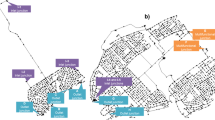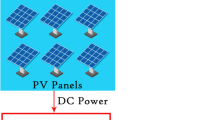Abstract
Pressure reducing valves (PRVs) are widely used to regulate pressures in the supply and distribution parts of water networks, by reducing the upstream pressure to a set outlet pressure (i.e., downstream of the PRV), usually referred to as set point. As all types of mechanical equipment, PRVs may exhibit malfunctions affecting pressure regulation, such as high frequency fluctuations around the set point and/or prolonged systematic deviations from the set point, allowing their detection to be approached in a statistical context. In this study, we develop a statistical framework for detection of PRV malfunctions in water supply and water distribution networks, which uses: (a) the root mean squared error as a proper statistical metric for monitoring the performance of PRVs by detecting individual malfunctions in high-resolution pressure time series, and (b) the hazard function concept to identify a proper duration of sequential events from (a) to issue alerts. The suggested methodology is implemented using pressure data at 1-min temporal resolution from pressure management area Diagora of the water distribution network of the city of Patras in Greece, for the 3-year period from 01/Jan./2017 to 31/Dec./2019. The obtained results show that the developed statistical approach effectively detects major PRV malfunctions as the issuance of alerts agrees well with the reported repair dates by the Municipal Enterprise of Water Supply and Sewerage of the City of Patras, allowing it to be used for operational purposes, while making it suitable for possible extensions to continuous monitoring and fault diagnosis of other types of mechanical equipment.












Similar content being viewed by others
References
Araujo L, Ramos H, Coelho S (2006) Pressure control for leakage minimisation in water distribution systems management. Water Resour Manag 20(1):133–149
Bates BC, Kundzewicz ZW, Wu. S, Palutikof JP (eds) (2008) Climate change and water, technical paper of the intergovernmental panel on climate change, IPCC Secretariat, Geneva, p 210. ISBN:978-92-9169-123-4
Benjamin JR, Cornell CA (1970) Probability, statistics and decision for civil engineers. McGraw-Hill, New York
Berardi L, Simone A, Laucelli D, Giustolisi O (2017) Feasibility of mass balance approach to water distribution network model calibration. Procedia Eng 186:551–558. doi: https://doi.org/10.1016/j.proeng.2017.03.269
Boano F, Scibetta M, Ridolfi L, Giustolisi O (2015) Water distribution system modeling and optimization: a case study. Procedia Eng 119:719–724. https://doi.org/10.1016/j.proeng.2015.08.925
Bohórquez J, Saldarriaga J, Vallejo D (2015) Pumping pattern optimization in order to reduce WDS operation costs. Procedia Eng 119:1069–1077. https://doi.org/10.1016/j.proeng.2015.08.936
Changklom J, Stoianov I (2017) Fault detection and diagnosis for pressure control valves in water supply networks. In: Proceedings of the computing and control for the water industry conference 2017, Sheffield, UK, 5–7 September 2017; p F143
Charalambous B, Foufeas D, Petroulias N, Publications EW (2014) Leak detection and water loss management. Water Utility J 8:25–30
De Paola F, Giugni M (2012) Leakages and pressure relation: an experimental research. Drink Water Eng Sci 5:59–65. https://doi.org/10.5194/dwes-5-59-2012
Deuerlein J, Cembrowicz RG, Dempe S (2005) Hydraulic simulation of water supply networks under control. In: World water and environmental resources congress EWRI05, 7th annual symposium on water distribution systems analysis, An-chorage, USA, May 15–19, 2005, ASCE, conference proceedings 173, p 24
Deuerlein J, Simpson AR, Wilkins S (2007) Solving for the status of pressure regulating valves using Nash equilibrium. In: Proceedings of the 9th annual international symposium on water distribution systems analysis. ASCE, Reston
Emmanouil S, Langousis A, Nikolopoulos EI, Anagnostou EN (2021) An ERA-5 derived CONUS-wide high-resolution precipitation dataset based on a refined parametric statistical downscaling framework. Water Resour Res. https://doi.org/10.1029/2020WR029548
Emmanouil S, Langousis A, Nikolopoulos EI, Anagnostou EN (2022) The spatiotemporal evolution of rainfall extremes in a changing climate: A CONUS-wide assessment based on multifractal scaling arguments. Earth’s Future. https://doi.org/10.1029/2021EF002539
Farley MR (1985) District metering. Part 1-system design and installation. WRc, Swindon
Farley MR, Trow S (2003) Losses in water distribution networks. In: A practitioner’s guide to assessment, monitoring and control, London, IWA, pp 146–149. ISBN:1 900222-11-6
Farley B, Mounce S, Boxall J (2010) Field testing of an optimal sensor placement methodology for event detection in an urban water distribution network. Urban Water J 7(6):345–356
Ferrari G, Savic D (2015) Economic performance of DMAs in water distribution systems. Procedia Eng 119:189–195. https://doi.org/10.1016/j.proeng.2015.08.874
Fontana N, Giugni M, Glielmo L, Marini G, Verrilli F (2017) A lab prototype of pressure control in water distribution networks. IFAC Papers OnLine 50(1):15373–15378. https://doi.org/10.1016/j.ifacol.2017.08.1859
Galuppini G, Magni L, Creaco E (2020) Stability and robustness of real time pressure control in water distribution systems. J Hydraul Eng 146(14):04020023
Garcia-Avila F, Avilés-Añazco A, Ordoñez-Jara J, Guanuchi-Quezada C, del Pino LF, Ramos-Fernadez L (2019) Pressure management for leakage reduction using pressure reducing valves. Case study in an Andean City. Alex Eng J 58:1313–1326
Gomes R, Sousa J, Sá Marques A (2014) Influence of future water demand patterns on the district metered areas design and benefits yielded by pressure management. Procedia Eng 70:744–752. https://doi.org/10.1016/j.proeng.2014.02.08
IPCC (2007) Summary for policymakers, In: Solomon S (ed) Climate change 2007: the physical science basis. Contribution of working group I to the fourth assessment report of the intergovernmental Panel on Climate Change. Cambridge University Press, Cambridge
Jose N, Sumam K (2016) Optimal water distribution network design accounting for valve closure. Procedia Technol 24:332–338
Kanakoudis V, Tsitsifli S (2010) Results of an urban water distribution network performance evaluation attempt in Greece. Urban Water J 7(5):267–285. https://doi.org/10.1080/1573062X.2010.509436
Lambert A, Taylor R (2010) Water loss guidelines–water New Zealand. ISBN:978-0-9941243-2-6
Langousis A, Kaleris V (2014) Statistical framework to simulate daily rainfall series conditional on upper-air predictor variables. Water Resour Res 50. https://doi.org/10.1002/2013WR014936
Langousis A, Mamalakis A, Deidda R, Marrocu M (2016) Assessing the relative effectiveness of statistical downscaling and distribution mapping in reproducing rainfall statistics based on climate model results. Water Resour Res 52. https://doi.org/10.1002/2015WR017556
Mamalakis A, Langousis A, Deidda R, Marrocu M (2017) A parametric approach for simultaneous bias correction and high-resolution downscaling of climate model rainfall. Water Resour Res 53:WRCR22499. doi: https://doi.org/10.1002/2016WR019578
Piller O, Bremond B (2001) Modeling of pressure regulating devices: a problem now solved, In: Phelps D, Sheike G (eds) Bridging the gap: meeting the world’s water and environmental resources challenges, pp 1–10 . https://doi.org/10.1061/40569(2001)394
Piller O, Van Zyl JE (2014) Modeling control valves in water distribution systems using a continuous state formulation. J Hydraul Eng 140(11):04014052. https://doi.org/10.1061/(ASCE)HY.1943-7900.0000920
Prescott S, Ulanicki B (2008) Improved control of pressure reducing valves in water distribution networks. J Hydraul Eng 134(1):56–65. https://doi.org/10.1061/(ASCE)0733-9429
Schwaller J, van Zyl JE (2014) Implications of the known pressure-response of individual leaks for whole distribution systems. Procedia Eng 70:1513–1517. https://doi.org/10.1016/j.proeng.2014.02.166
Serafeim AV, Kokosalakis G, Deidda R, Karathanasi I, Langousis A (2021) Probabilistic estimation of minimum night flow in water distribution networks: large-scale application to the city of Patras in western Greece. Stoch Environ Res Risk Assess 36:643–660. https://doi.org/10.1007/s00477-021-02042-9
Serafeim AV, Kokosalakis G, Deidda R, Karathanasi I, Langousis A (2022) Probabilistic minimum night flow estimation in water distribution networks and comparison with the water balance approach: large-scale application to the City Center of Patras in Western Greece. Water 14:98. https://doi.org/10.3390/w14010098
Signoreti ROS, Camargo RZ, Canno LM, Pires MSG, Ribeiro LCLJ (2016) Importance of pressure reducing valves (PRVs) in water supply networks. JPCS 738
Singh VP (1992) Elementary hydrology. Prentice-Hall, New Jersey
van Zyl JE (2014) Theoretical modeling of pressure and leakage in water distribution systems. Procedia Eng 89:273–277. https://doi.org/10.1016/j.proeng.2014.11.187
Wright R, Abraham E, Parpas P, Stoianov I (2015) Optimized control of pressure reducing valves in water distribution networks with dynamic topology. Procedia Eng 119:1003–1011
Ziegler D, Sorg F, Fallis P, Hübschen K, Happich L, Baader J, Trujillo R, Mutz D, Oertlé E, Klingel P, Knobloch P (2012) Guidelines for water loss reduction, a focus on pressure management, Deutsche Gesellschaft für Internationale Zusammenarbeit. GIZ) GmbH and VAG Armaturen GmbH, p 236
Acknowledgements
This research work has been conducted within the project PerManeNt, which has been co-financed by the European Regional Development Fund of the European Union and Greek national funds through the Operational Program Competitiveness, Entrepreneurship and Innovation, under the call RESEARCH – CREATE – INNOVATE (Project Code: T2EDK-04177). The Authors would like to explicitly acknowledge the constructive comments and suggestions received by two anonymous Reviewers, which helped them to improve the presented work.
Funding
This research work has been conducted within the project PerManeNt, which has been co-financed by the European Regional Development Fund of the European Union and Greek national funds through the Operational Program Competitiveness, Entrepreneurship and Innovation, under the call RESEARCH – CREATE – INNOVATE (Project Code: T2EDK-04177).
Author information
Authors and Affiliations
Corresponding author
Ethics declarations
Conflict of interest
The Authors declare that they have no known competing financial interests or personal relationships that could have appeared to influence the work reported in this paper.
Additional information
Publisher’s note
Springer Nature remains neutral with regard to jurisdictional claims in published maps and institutional affiliations.
Rights and permissions
About this article
Cite this article
Perdios, A., Kokosalakis, G., Th. Fourniotis, N. et al. Statistical framework for the detection of pressure regulation malfunctions and issuance of alerts in water distribution networks. Stoch Environ Res Risk Assess 36, 4223–4233 (2022). https://doi.org/10.1007/s00477-022-02256-5
Accepted:
Published:
Issue Date:
DOI: https://doi.org/10.1007/s00477-022-02256-5




